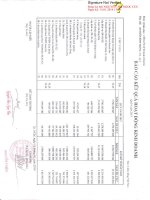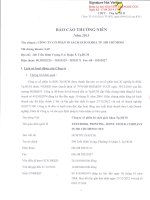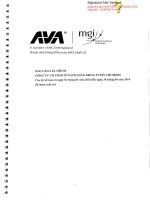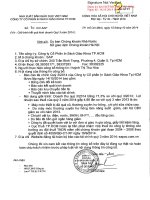Study of genetic divergence in pea (Pisum sativum L.) based on agro-morphic traits - Trường Đại học Công nghiệp Thực phẩm Tp. Hồ Chí Minh
Bạn đang xem bản rút gọn của tài liệu. Xem và tải ngay bản đầy đủ của tài liệu tại đây (283.52 KB, 6 trang )
<span class='text_page_counter'>(1)</span><div class='page_container' data-page=1>
<i><b>Int.J.Curr.Microbiol.App.Sci </b></i><b>(2017)</b><i><b> 6</b></i><b>(11): 3816-3821 </b>
3816
<b>Original Research Article </b>
<b>Study of Genetic Divergence in Pea (</b>
<i><b>Pisum sativum</b></i>
<b> L.) </b>
<b>based on Agro-Morphic Traits </b>
<b>Archi Gupta1, M.K. Singh1, Mukesh Kumar1, S.K. Singh2, </b>
<b>Hariom Katiyar3 and Vipin Kumar1*</b>
1
Department of Horticulture, 2Department of Genetics and Plant Breeding, 3Directorate of
Extension, SVPUAT, Meerut-250110, UP, India
<i>*Corresponding author </i>
<i><b> </b></i> <i><b> </b></i><b>A B S T R A C T </b>
<i><b> </b></i>
<b>Introduction </b>
Vegetables are truly known as functional food
and contain those ingredients that add bodily
functional food in addition being nutritious
and are also known as protective food. They
are rich source of vitamins, carbohydrates,
proteins etc. Vegetables are commonly used
as culinary purposes.
Pea (<i>Pisum sativum </i> L.) is a very unique
nutritious vegetable and used in Indian
kitchen. Pea has unique distinction on account
of their utility as pulse as well as vegetable.
Green pea is generally used as vegetable.
It is a highly nutritious vegetable and contains
digestible protein 7.2g, carbohydrates 15.8g,
fat 0.1 g, vitamins like vitamin C 9 mg,
vitamin A 139 IU and minerals like calcium
20.0 mg phosphorus 139 mg, iron 1.5 mg
(Choudhary, 1990). Besides these, pea adds
additional plant nutrient like nitrogen in soil
by nitrogen fixation by useful bacteria i.e.,
rhizobium. Pea belongs to the family
<i>Leguminosae </i> (<i>Fabaceae</i>) and having
chromosome number 2n = 14. It is an annual
herbaceous plant and commonly known as
leguminous vegetable crop. Pea is an
important plant in human and animal nutrition
<i>International Journal of Current Microbiology and Applied Sciences </i>
<i><b>ISSN: 2319-7706</b></i><b> Volume 6 Number 11 (2017) pp. 3816-3821 </b>
Journal homepage:
The investigation was carried out with 20 genotypes of pea (<i>Pisum sativum</i> L.) at
Horticulture Research Centre (HRC) of SVPUAT, Meerut, UP during 2016-17 to study the
genetic diversity among the genotypes. The experiment was laid down in randomized
block design (RBD) with 03 replications. The experiment having 10 observations on the
basis of 5 randomly selected plants from each replication. D2 analysis grouped into four
clusters showing the existence of considerable amount of variation among the genotypes.
Maximum pod yield 73.20 q/ha was found in PB-89 genotype. Cluster pattern revealed
that, cluster III had largest number of genotypes (10) followed by cluster II (5 genotypes),
cluster IV (3 genotypes) and cluster I had only (2 genotypes). Highest intra cluster distance
were found cluster II (D2 =1.983) whereas, highest inter cluster distance was observed
between cluster III and I (D2 = 6.627). The cluster means revealed the best cluster for
various growth and flowering traits, depending upon the aim of breeding, hence the
potential line can be selected from different clusters as parents.
<b>K e y w o r d s </b>
Genetic divergence,
Agro-morphic traits,
Horticulture
<i><b>Accepted: </b></i>
28 September 2017
<i><b>Available Online:</b></i>
10 November 2017
</div>
<span class='text_page_counter'>(2)</span><div class='page_container' data-page=2>
<i><b>Int.J.Curr.Microbiol.App.Sci </b></i><b>(2017)</b><i><b> 6</b></i><b>(11): 3816-3821 </b>
3817
because of it has high protein content 23-
33%. Green peas are eaten cooked as a
vegetable and are marketed fresh, canned or
frozen. Peas are rich in health benefiting
phyto-nutrients, minerals, vitamins and
anti-oxidants.
The breeder need to isolate the suitable
genotypes on the basis of genetic divergence
for the hybridization purpose, Mahalanodis
D2 statistics techniques based on multivariate
analysis of quantitative among the group. It
also pin–points suitable genotype for their
utilization in hybridization programmes.
In order to produce transgressive segregants
and genetically different parents must to be
selected for recombination breeding in
self-pollinated crops. The characterization of
genetic diversity in crop species has long been
based on morphological attributes, however,
morphological variation is often found to be
of limited use because the expression of
morphological attributes may be affected by
environmental conditions, thereby
constraining the analysis of genetic variation
(Nisar <i>et al.,</i> 2008). On the basis of
morphological data, genetic diversity
assessments needs a high precision of field
experiments through recommended design
and analysis so that the germplasm may be
exploited to develop better genotypes for the
upcoming scenario (Sajjad <i>et al.,</i> 2011).
Knowledge of genetic diversity is a useful
tool in gene bank management and in
planning experiments, as it facilitates efficient
sampling and utilization of germplasm by
identifying and/or eliminating duplicates in
the gene stock and helps in the establishment
of core collections (Ghafoor <i>et al., </i>2005).
<b>Materials and Methods </b>
A total of 20 genotypes of pea collected for
divergence study (Table 3). The present
investigations were carried out in 2016-17 at
Research Farm of HRC, SVPUAT, Meerut in
RBD method with three replications. Each
plot comprised one row of 1.8 m length
spaced 45 cm with plant to plant and row to
row is 10 cm. All the recommended cultural
practices were followed under irrigated
conditions as and when needed. The
observations were recorded on five random
competitive plants per replication for each
genotype of ten important characters <i>i.e.</i> days
to 50% flowering, plant height (cm), number
of first fruiting node, length of first fruiting
node (cm), number of pods per plant, length
of pod (cm), width of pod (cm), number of
seeds per pod, pod yield per plant (g), pod
yield (q/ha). The Mahalanobis D2 (1936)
statical method was used to quantify genetic
diversity among the genotypes. The D2 values
were used to classify the entire germplasm
into distinct clusters, which was done
following to Tocher’s method [Rao (1952)].
<b>Results and Discussion </b>
The analysis of variance for 20 genotypes of
pea revealed significant difference for all the
10 characters, which indicated the presence of
wide spectrum of variability among the
genotypes. The minimum flowering duration
(32.67) was observed with the cultivar E-6
and plant height was observed with the
genotypes Sel- 3. Genotype Sel- 7 is having
maximum first fruiting node (14.57). The
maximum length of first fruiting node was
recorded in Sel-3 (47.03cm). Very optimum
dose of NPK reduce the days taken to
flowering up to a certain limit and vice versa.
Similar results were coated by Naeem <i>et al.,</i>
(2002) for chilli.
</div>
<span class='text_page_counter'>(3)</span><div class='page_container' data-page=3>
<i><b>Int.J.Curr.Microbiol.App.Sci </b></i><b>(2017)</b><i><b> 6</b></i><b>(11): 3816-3821 </b>
3818
rainfall, humidity etc. The deficiency of major
nutrients stunted the plant growth, resulting
the maximum days taken to flowering. The
cultivar KS-156 had maximum number of
seeds (9.53). Pod yield per plant and pod
yield q/ha is highest in PB 89 i.e. 182.99 g
and 73.20q/ha respectively. The plants treated
with different combinations of NPK and
NADEP compost results in to higher length of
pods. Similar results were reported by Parsad
<i>et al.,</i> (2005).
<b>Table.1 </b>ANOVA
Source of
Variation DF
Days to
50%
flowering
Plant
height
(cm)
Number
of first
fruiting
node
Length
of first
fruiting
node
(cm)
Number
of pods
per plant
Length
of pod
(cm)
Width
of pod
(cm)
seeds
per
pod
pod
yield
q/ha
pod
yield
per
plant(g)
Replicatio
n 2 4.55 0.66 0.05 0.68 0.52 0.20 0.00 0.01 0.05 0.01
Treatment 19 195.60** 944.88
** 5.37**
186.58*
*
137.56
** 1.88**
0.01*
*
3.50
**
2050.9
3**
328.16
**
Error 38 1.32 0.64 0.42 0.24 0.20 0.18 0.00 0.24 2.98 0.48
<b>Table.2 </b>Average of intra and inter cluster distance
Clusters I II III IV
I <b>1.943 </b> 5.917 6.627 6.304
II <b>1.983 </b> 2.82 3.86
III <b>1.976 </b> 2.763
</div>
<span class='text_page_counter'>(4)</span><div class='page_container' data-page=4>
<i><b>Int.J.Curr.Microbiol.App.Sci </b></i><b>(2017)</b><i><b> 6</b></i><b>(11): 3816-3821 </b>
3819
<b>Table.3 </b>Mean performance of 20 genotypes of pea for 10 characters
<b>S.no. </b> <b></b>
<b>Geno-types </b>
<b>Days to </b>
<b>50% </b>
<b>flowering </b>
<b>Plant </b>
<b>height </b>
<b>(cm) </b>
<b>Number of </b>
<b>first fruiting </b>
<b>node </b>
<b>Length of first </b>
<b>fruiting </b>
<b>node(cm) </b>
<b>Number of </b>
<b>pods per </b>
<b>plant </b>
<b>Length </b>
<b>of pod </b>
<b>(cm) </b>
<b>Width of </b>
<b>pod (cm) </b>
<b>seeds</b>
<b>/ pod </b>
<b>pod yield </b>
<b>/plant(g) </b>
<b>pod yield </b>
<b>q/ha </b>
<b>1 AP-1 </b> 52.67 82.45 11.67 37.25 34.87 9.35 1.26 8.60 141.15 56.46
<b>2 KS-156 </b> 46.33 45.36 12.87 31.42 32.40 9.35 1.32 9.53 150.66 60.27
<b>3 KS-210 </b> 55.33 55.37 14.07 46.07 38.60 8.63 1.25 7.73 164.81 65.93
<b>4 AP-4 </b> 50.33 56.00 13.67 37.26 31.67 9.41 1.23 8.73 124.51 49.80
<b>5 KS-149 </b> 55.33 55.51 13.73 36.77 28.73 10.09 1.49 9.20 129.91 51.96
<b>6 KS-205 </b> 54.67 56.31 13.40 41.12 36.13 8.72 1.33 7.33 170.98 68.39
<b>7 PB-89 </b> 52.67 54.39 11.53 45.55 37.40 7.17 1.35 8.33 182.99 73.20
<b>8 AP-2 </b> 62.33 64.73 12.53 46.75 26.27 8.44 1.34 5.80 112.96 45.18
<b>9 AP-3 </b> 35.67 37.34 11.53 28.49 32.80 9.33 1.31 9.27 148.93 59.57
<b>10 E-6 </b> 32.67 32.27 8.87 17.23 11.60 7.37 1.25 6.73 64.20 25.68
<b>11 Sel-1 </b> 48.67 48.19 13.07 31.71 32.87 9.21 1.32 9.20 147.21 58.89
<b>12 Sel-2 </b> 55.33 88.18 12.60 46.25 38.20 8.25 1.29 7.20 157.79 63.12
<b>13 Sel-3 </b> 53.67 96.37 12.93 47.03 35.07 9.42 1.32 6.73 148.59 59.44
<b>14 Sel-4 </b> 58.33 75.69 13.67 35.33 36.40 7.58 1.23 8.27 154.79 61.92
<b>15 Sel-5 </b> 38.67 53.98 10.60 23.99 17.73 9.16 1.29 6.80 102.40 40.96
<b>16 Sel-6 </b> 34.67 76.13 13.87 38.52 31.27 8.55 1.24 8.80 134.85 53.94
<b>17 Sel-7 </b> 51.67 68.30 14.53 38.05 35.27 8.06 1.25 7.40 140.73 56.29
<b>18 Sel-8 </b> 49.33 78.44 12.33 39.27 36.73 8.70 1.26 8.73 149.40 59.76
<b>19 Sel-9 </b> 50.33 90.41 13.53 42.01 29.27 9.04 1.30 6.73 122.18 48.87
<b>20 Sel-10 </b> 48.33 69.13 12.67 35.87 32.87 7.69 1.23 8.67 132.13 52.85
<b>Mean </b> <b>49.35 </b> <b>64.23 </b> <b>12.68 </b> <b>37.30 </b> <b>31.81 </b> <b>8.68 </b> <b>1.29 </b> <b>7.99 </b> <b>139.06 </b> <b>55.62 </b>
<b>Range </b> 32.67 32.27 8.87 17.23 11.60 7.17 1.23 5.80 64.20 25.68
62.33 96.37 14.53 47.03 38.60 10.09 1.49 9.53 182.99 73.20
<b>SE </b> 0.94 0.65 0.53 0.40 0.36 0.35 0.03 0.40 1.41 0.56
<b>CD at 5% </b> 1.99 1.38 1.12 0.85 0.77 0.73 0.07 0.85 2.98 1.19
</div>
<span class='text_page_counter'>(5)</span><div class='page_container' data-page=5>
<i><b>Int.J.Curr.Microbiol.App.Sci </b></i><b>(2017)</b><i><b> 6</b></i><b>(11): 3816-3821 </b>
3820
<b>Table.4 </b>Cluster mean of 10 characters of pea
<b>Cluster</b>
<b>s </b>
<b>Days to </b>
<b>50% </b>
<b>flowerin</b>
<b>g </b>
<b>Plant </b>
<b>height </b>
<b>(cm) </b>
<b>Numbe</b>
<b>r of </b>
<b>first </b>
<b>fruiting </b>
<b>node </b>
<b>Lengt</b>
<b>h of </b>
<b>first </b>
<b>fruitin</b>
<b>g node </b>
<b>(cm) </b>
<b>Numb</b>
<b>er of </b>
<b>pods </b>
<b>per </b>
<b>plant </b>
<b>Lengt</b>
<b>h of </b>
<b>pod </b>
<b>(cm) </b>
<b>Width </b>
<b>of pod </b>
<b>(cm) </b>
<b>Numb</b>
<b>er of </b>
<b>seeds </b>
<b>per </b>
<b>pod </b>
<b>pod </b>
<b>yield </b>
<b>per </b>
<b>plant(</b>
<b>g) </b>
<b>pod </b>
<b>yield </b>
<b>q/ha) </b>
<b>I </b> Mean 35.67 43.13 9.73 20.61 14.67 8.27 1.27 6.77 83.30 33.32
<b>II </b> Mean 47.27 48.48 12.97 33.13 31.69 9.48 1.34 9.19 140.24 56.10
<b>III </b> Mean 51.30 70.44 13.03 40.33 35.77 8.27 1.27 8.11 152.96 61.19
<b>IV </b> Mean 55.44 83.84 13.00 45.26 30.20 8.97 1.32 6.42 127.91 51.16
<b>Table.5 </b>Clustering pattern of 20 genotypes of pea on the basis of genetic divergence
On the basis of Mahalanobis D2 analysis, total
20 genotypes were studied and grouped into
four clusters. The distribution patterns of pea
genotypes into four clusters are presented in
Table 5. The maximum number of genotypes
10 was found in cluster III with comprising
AP-1, KS-210, KS-205, PB -89,
SELECTION-2, SELECTION-4, SELECTION-6,
7, 8,
SELECTION-10. The second highest number of genotypes
(5) were claimed under cluster II namely
KS-156, AP-4, KS-149, AP-3, SELCTION-1. The
cluster IV comprising was found (3)
genotypes namely AP-2, SELECTION-3,
SELECTION-9, while cluster I containing (2)
genotypes namely E-6, SELECTION-5.
The average intra and inter cluster D2 values
are presented in Table 2. The maximum inter
cluster D2 value (6.627) was recorded
between cluster III and I and the minimum
inter cluster D2 value (2.763) was recorded in
cluster IV and III. The maximum intra cluster
distance were found in cluster III (1.976)
followed by cluster I (1.943), cluster II
(1.983) and cluster IV (1.621). The maximum
inter cluster D2 values indicated that
genotypes of cluster III and I were not closely
related, whereas the genotypes of cluster IV
and III were found closely related due to
minimum inter cluster D2 values. It is
apparent therefore, the genotypes of cluster do
not differ significantly with regards to their
relative genetic distance as indicated from the
low variation of D2 values.
The success of breeding programmes depends
upon the genetic diversity present among the
parents. Divergence study suggested that
crosses among genotypes like KS-156, AP-4,
KS-149, AP-1, KS-210, KS-205 for getting
desired segregates from breeding point of
view.
<b>Clusters </b> <b>No of </b>
<b>genotypes </b> <b>Genotype name </b>
<b>I </b> 2 E-6, Selection-5
<b>II </b> 5 KS-156,AP-4,KS-149, AP-3,Selection-1
<b>III </b>
10
AP-1, KS-210, KS-205,PB-89,Selection-2, Selection-4, Selection-6,
Selection-7,Seletion-8, Selection-10
</div>
<span class='text_page_counter'>(6)</span><div class='page_container' data-page=6>
<i><b>Int.J.Curr.Microbiol.App.Sci </b></i><b>(2017)</b><i><b> 6</b></i><b>(11): 3816-3821 </b>
3821
<b>References </b>
Choudhary, B. 1990. Vegetables, National
Book Trust, India, A-5 Green Park,
New Delhi-16
Ghafoor, A., Ahmad, Z. and Anwar, R.
(2005). Genetic diversity in <i>Pisum </i>
<i>sativum </i>and a strategy for indigenous
biodiversity conservation<i>. </i> <i>Pakistan </i>
<i>Journal of Botany, </i>37: 71-77
Naeem, N.M. Irfan, J. Khan, G. Nabi N.
Muhammad and N. Badshah, 2002.
Influence of various levels of nitrogen
and phosphorus on growth and yield of
chilli (<i>Capsicum annum</i> L.) Asian J. Pl
Sci. 1: 599-601.
Nisar, M., Ghafoor, A., Ahmad, H., Khan, M.
R., Qureshi, A.S., Ali, H. and Islam,
M.(2008). Evaluation of genetic
diversity of pea germplasm through
phenotypic trait analysis.<i> Pak. J. Bot</i>.,
40(5): 2081-2086.
Prasad, Kader, Kumar Sanjay, Pyare, J.P.S.
(2005). Effect of FYM and biofertilizers
in conjunction with inorganic fertilizers
on growth, yield and profit of chick pea
(<i>Cicer arietinum</i> L.). <i>Plant achieves</i>
5(2): 609-612.
Rao, C.R. (1952). Advance Statistical
Methods in Biometrical Research (Ist
Edn). <i>John Willey and Sons, New York.</i>
Pp. 390. (1952).
Sajjad, M., Khan, S. and Khan, A. S. (2011).
Exploitation of germplasm for grain
yield improvement in spring wheat
(<i>Triticum </i> <i>aestivum</i>)<i>. </i> <i>International </i>
<i>Journal of Agriculture and Biology, </i>13:
695-700.
<b>How to cite this article: </b>
</div>
<!--links-->
Báo cáo tài chính năm 2015 (đã kiểm toán) - Công ty Cổ phần In Sách giáo khoa tại Tp.Hồ Chí Minh
- 29
- 174
- 0








